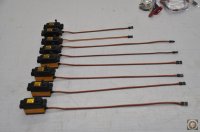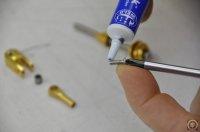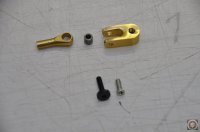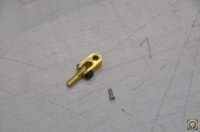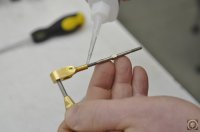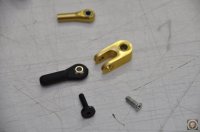I wanted to take a minute to talk about the gold hardware. I've had a lot of the PAU planes that we travel with and everywhere I go it seems someone asks me about it because it is different than what most ARF mfg's use. On most of my builds I use the G-10 horns but I have the ability to make my own after confirming the geometry. I have cut my own for ARF's before because many of them use a generic horn and I have found a few cases where the geometry is just plain wacky. With the threaded stud you have lots of adjustment to fine tune your geometry, especially when dealing with multiple servos on a single control surface. First thing people ask is "how well does it hold up", and my answer is extremely well. I have had a couple where the bushing gets a little sloppy from the shake of a DA120 after LOTS of hard flight time.
So here are some details and a few tips and options for you to add to your mental toolbox when using this hardware to get the best chance of success.
These are just some options to show the versatility of this hardware and different ways you can use it:
1 - It's not a bad idea to remove the screw and put a little blue locktite on the threads before installing on the plane. Tighten the screw, but not so tight that the ball link binds!!
2 - If you use Savox servos you undoubtedly have tossed these hardened black screws with the allen heads in the garbage a time or two. If you still have them they are wonderful to put in place of the stock screw because they are hardened and will last even longer.
3 - A little ahead here, but once you have your servos all set up in your plane and you are ready to fly, put a drop of thin CA where the push rod goes into the ball link. Since this is a metal to metal link that is not "tightened" it can be prone to vibrations. A drop of CA makes things all better. Threadlock would work but since you do this after adjustment, you don't want to un-thread it and thread it back on to risk messing up your perfectly matched servos.
4 - Another thing that I discovered after a little brain storming is that a Dubro ball link exactly fits the space of the stock gold link!!! This option also allows for a little side to side motion without the gold connector having to rotate on the threaded stud quite as much. If you choose this method, you need to lock the clevis that threads onto the control horn to keep it from rotating. Either a lock nut on top, a dab of "goop" on top and bottom (removable if needed) works well.
So you can see that this hardware is quite versatile to fit any application and user preference!
 . I also replace the screws with hex head screws from RTL to avoid the striped screw heads of the factory Phillips heads.
. I also replace the screws with hex head screws from RTL to avoid the striped screw heads of the factory Phillips heads.


